




 |
|
|||||||||||||||||||||
 |
|
|
|
|
|
|
|
|
|
|||||||||||||
|
|
|
|
|
|
||||||||||||||||||
|
|
|
|
|
|
|
|
|
|
||||||||||||||
|
|
|
|
|
|
||||||||||||||||||
|
|
|
|
|
|
|
|
|
|
||||||||||||||
|
|
|
|
|
|
||||||||||||||||||
|
|
|
|
|
|
|
 |
|
|||||||||||||||
 |
 |
|
||||||||||||||||||||
|
|
|
|
||||||||||||||||||||
|
|
|
|
|
|
|
|
|
|
|
|
|
|
|
|
|
|
|
|
|
|
|
|
| Hybrids of Timor and Australian Zebra Finches | |||||||
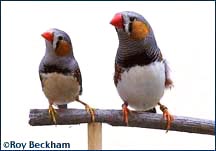 |
• Why Create Hybrids?
• Australian x Timor Hybrid • Timor x Australian Hybrid • Hybrid x Hybrid • Timor x Hybrid |
||||||
| Timor (L), Australian (R) Zebra Finches | |||||||

|
Why Create Hybrids? Whether intentionally or accidentally produced, I feel that breeders have a responsibility to inform those that receive hybrids of their genetic make up. I consider it unethical to knowingly sell a hybrid as a pure species. Hybrids usually have physical as well as behavior differences derived from both of their parents and in some cases this can effect their expected socialization with other birds. In the case of the Timor Zebra finch (Taeniopygia guttata guttata), part of their appeal is the unique characteristics that are similar, but distinctly different from their vastly popular and domesticated subspecies, the Australian Zebra finch (Taeniopygia guttata castanotis). Quite often the first question asked when I discuss the Timor Zebras, (and I asked this myself when first purchasing them) is 'are they pure or hybrids?' The reason for this question is partly fueled by their rarity in aviculture, and also the desire to keep those characteristics that are unique to the Timor pure. With that said, why have I produced hybrids of the Timor and Australian zebra finch? To show others and myself what the hybrids look like so that we can identify any hybrids that might be produced. I feel that it is important to keep the two species separate and distinct and being able to identify any hybrids prior to purchase will help keep our lines pure by avoiding the introduction of hybrids. The hybrids that I have produced for this study are all close banded with a black band with the word 'HYBRID' stamped in it. Also on that leg is a dated close band with my initials and a unique number. After reaching maturity and being photographed, all hybrids will be sent to a university for a study on immune system response in estrildid finch hybrids. There the study of hybridization may help us understand the process of speciation better. The close band will remain on the birds for their life to identify them as hybrids to any individual that may somehow receive them. I recommend anyone who produces hybrids, intentionally or accidentally, band their birds with similar bands. |
| Australian (male) x Timor (female) Hybrid - (T. g. castanotis x T. g. guttata) | ||||||||
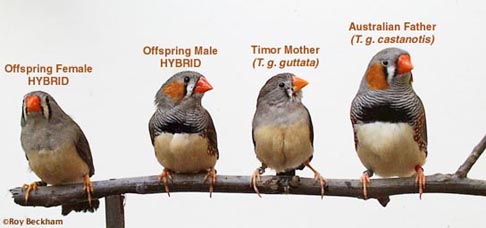 |
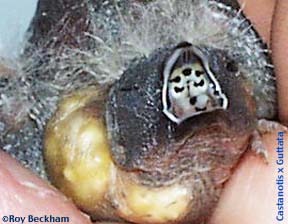 |
|||||||
| Mouth markings of castanotis x guttata Compare with other finch mouth markings |
||||||||
| Hybrid 1 Weight Results Australian male weight: 20.6 g Timor female weight: 10.7 g Average Hybrid Weight Clutch #2 |
||||||||
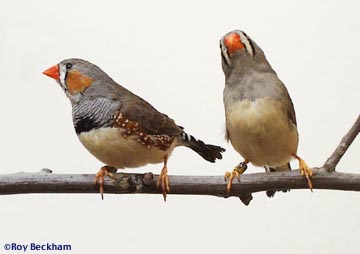 |
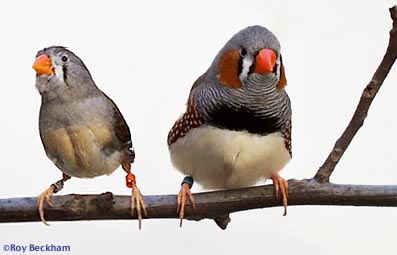 |
|||||||
| Timor female (L) & Australian male (R) An F1 Timor female mated with a show standard Australian male |
||||||||
| Australian x Timor Hybrid (click to see male's throat detail) |
||||||||
| I must admit that I was surprised to see that the hybrid male did not show more of a blended appearance to the markings. It shows to some degree the dominance of the Australian Zebra in this mating. The advantage to this is that in an effort to keep the Timor Zebra blood lines pure, it will be easy to avoid males created from this hybrid. The females can be more of a problem. There are no physical differences between any of the females. Size cannot be used since the Australian male used is a larger show type. If a smaller Australian male were used, I would expect the hybrids to be smaller as well even approaching the size of the Timor Zebra. | ||||||||
| Timor (male) x Australian (female) Hybrid - (T. g. guttata x T. g. castanotis) | |||||||||
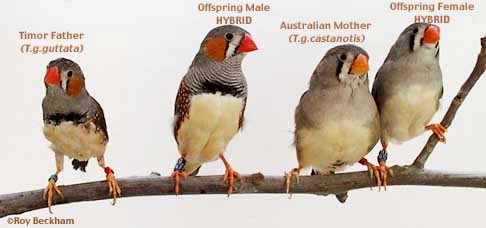 |
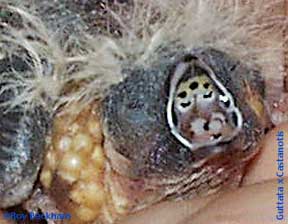 |
||||||||
| Mouth markings of guttata x castanotis Compare with other finch mouth markings |
|||||||||
| Hybrid 2 Weight Results Timor male weight: 10.6 g Australian female weight: 23.2 g Average Hybrid Weight Clutch #2 |
|||||||||
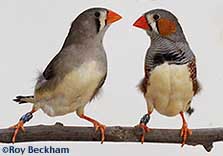 |
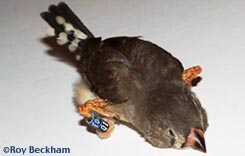 |
||||||||
| Timor x Australian Hybrids | Timor x Australian Hybrid - One of the deformities observed. | ||||||||
| Some deformities were seen in this cross. It has not been determined if it was a result of the hybridization, this particular pair or some other environmental or nutritional problem. One had five toes and legs that pointed upwards (see above and left), while another just had the legs that pointed up. Further study would be needed to determine the cause of these deformities and if there is any connection to the hybridization. A friend suggested the following:
"I have been reading about the development of reproductive isolation. In particular postmating barriers, one authors suggests that gene complementarity is the cause of genetic disruption leading to inviability or morphological defects. Genes that in their original host are just fine and beneficial become detrimental once in a different genetic background (epistasis). These mechanism has been suggested as the most common in fruit flies and probably it is what happened to the cross between the Timor and Australian Zebra Finches." Juan Esteban Martinez-Gomez |
|||||||||
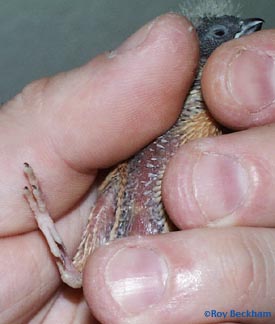 |
|||||||||
| Hybrid (male) x Hybrid (female) Mating - (guttata x castanotis X castanotis x guttata) | |||||
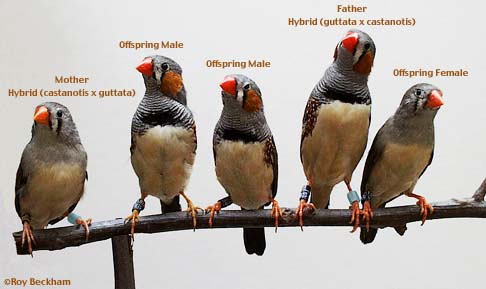 |
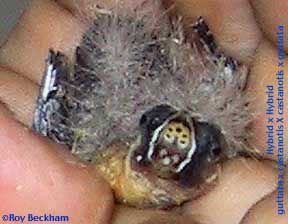 |
||||
| Mouth markings of hybrid x hybrid Compare with other finch mouth markings |
|||||
| Hybrid 3 Weight Results Hybrid male weight: 19.1 g Hybrid female weight: 15.2 g Average Hybrid Weight Clutch #2 |
|||||
| Somehow I thought that I might see more variation in the phenotype of the males. I thought that I might see a range of markings with some approaching a more Timor Zebra like appearance. This did not occur. All the males produced (five males in the first clutch and three in the second) were very consistent. All looked very similar to the blended appearance of their hybrid parents. In fact, if there was any drift in the appearance, the males had more definition in the throat stripes and appeared more like the Australian race than the Timors. Fertility was high with the hybrid x hybrid pairings. In both pairings, the fertility was greater than 80%, with the first pair (guttata x castanotis X castanotis x guttata) nearing 100% fertility. The second pair (castanotis x guttata X guttata x castanotis), even though their eggs had high fertitility, proved to be unreliable parents and did not sit consistently. Consequently, only two young were produced and these resembled the first pair's offspring. | |||||
| Timor (male) x Hybrid (female) Mating - (T. g. guttata X castanotis x guttata) | |||||
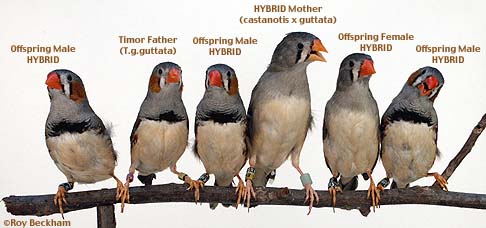 |
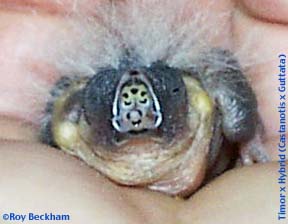 |
||||
| Mouth markings of Timor x hybrid Compare with other finch mouth markings |
|||||
| Hybrid 4 Weight Results Timor male weight: 20.6 g Hybrid female weight: 10.7 g Average Hybrid Weight Clutch #2 |
|||||
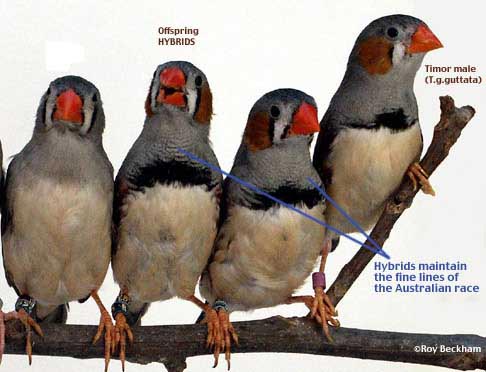 |
|||||
| This backcross was used to see if the offspring could return to a more Timor-like appearance.
More observations and conclusions to come...... |
|||||
